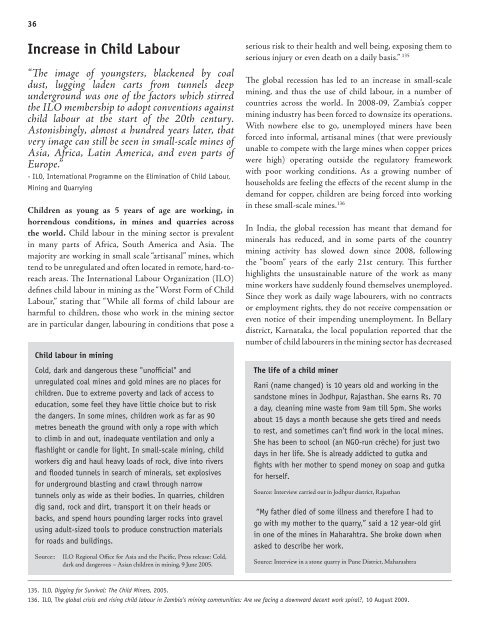Children - Terre des Hommes
Children - Terre des Hommes
Children - Terre des Hommes
Create successful ePaper yourself
Turn your PDF publications into a flip-book with our unique Google optimized e-Paper software.
36<br />
Increase in Child Labour<br />
“The image of youngsters, blackened by coal<br />
dust, lugging laden carts from tunnels deep<br />
underground was one of the factors which stirred<br />
the ILO membership to adopt conventions against<br />
child labour at the start of the 20th century.<br />
Astonishingly, almost a hundred years later, that<br />
very image can still be seen in small-scale mines of<br />
Asia, Africa, Latin America, and even parts of<br />
Europe.”<br />
- ILO, International Programme on the Elimination of Child Labour,<br />
Mining and Quarrying<br />
<strong>Children</strong> as young as 5 years of age are working, in<br />
horrendous conditions, in mines and quarries across<br />
the world. Child labour in the mining sector is prevalent<br />
in many parts of Africa, South America and Asia. The<br />
majority are working in small scale “artisanal” mines, which<br />
tend to be unregulated and often located in remote, hard-toreach<br />
areas. The International Labour Organization (ILO)<br />
defines child labour in mining as the “Worst Form of Child<br />
Labour,” stating that “While all forms of child labour are<br />
harmful to children, those who work in the mining sector<br />
are in particular danger, labouring in conditions that pose a<br />
Child labour in mining<br />
Cold, dark and dangerous these "unofficial" and<br />
unregulated coal mines and gold mines are no places for<br />
children. Due to extreme poverty and lack of access to<br />
education, some feel they have little choice but to risk<br />
the dangers. In some mines, children work as far as 90<br />
metres beneath the ground with only a rope with which<br />
to climb in and out, inadequate ventilation and only a<br />
flashlight or candle for light. In small-scale mining, child<br />
workers dig and haul heavy loads of rock, dive into rivers<br />
and flooded tunnels in search of minerals, set explosives<br />
for underground blasting and crawl through narrow<br />
tunnels only as wide as their bodies. In quarries, children<br />
dig sand, rock and dirt, transport it on their heads or<br />
backs, and spend hours pounding larger rocks into gravel<br />
using adult-sized tools to produce construction materials<br />
for roads and buildings.<br />
Source::<br />
ILO Regional Office for Asia and the Pacific, Press release: Cold,<br />
<br />
serious risk to their health and well being, exposing them to<br />
serious injury or even death on a daily basis.” 135<br />
The global recession has led to an increase in small-scale<br />
mining, and thus the use of child labour, in a number of<br />
<br />
mining industry has been forced to downsize its operations.<br />
With nowhere else to go, unemployed miners have been<br />
forced into informal, artisanal mines (that were previously<br />
unable to compete with the large mines when copper prices<br />
were high) operating outside the regulatory framework<br />
with poor working conditions. As a growing number of<br />
households are feeling the effects of the recent slump in the<br />
demand for copper, children are being forced into working<br />
in these small-scale mines. <br />
In India, the global recession has meant that demand for<br />
minerals has reduced, and in some parts of the country<br />
mining activity has slowed down since 2008, following<br />
the “boom” years of the early 21st century. This further<br />
highlights the unsustainable nature of the work as many<br />
mine workers have suddenly found themselves unemployed.<br />
Since they work as daily wage labourers, with no contracts<br />
or employment rights, they do not receive compensation or<br />
even notice of their impending unemployment. In Bellary<br />
district, Karnataka, the local population reported that the<br />
number of child labourers in the mining sector has decreased<br />
The life of a child miner<br />
Rani (name changed) is 10 years old and working in the<br />
sandstone mines in Jodhpur, Rajasthan. She earns Rs. 70<br />
a day, cleaning mine waste from 9am till 5pm. She works<br />
about 15 days a month because she gets tired and needs<br />
to rest, and sometimes can’t find work in the local mines.<br />
She has been to school (an NGO-run crèche) for just two<br />
days in her life. She is already addicted to gutka and<br />
fights with her mother to spend money on soap and gutka<br />
for herself.<br />
Source: Interview carried out in Jodhpur district, Rajasthan<br />
“My father died of some illness and therefore I had to<br />
go with my mother to the quarry,” said a 12 year-old girl<br />
in one of the mines in Maharahtra. She broke down when<br />
asked to <strong>des</strong>cribe her work.<br />
Source: Interview in a stone quarry in Pune District, Maharashtra<br />
135. ILO, Digging for Survival: The Child Miners, 2005.<br />
136. ILO, The global crisis and rising child labour in Zambia’s mining communities: Are we facing a downward decent work spiral?, 10 August 2009.






